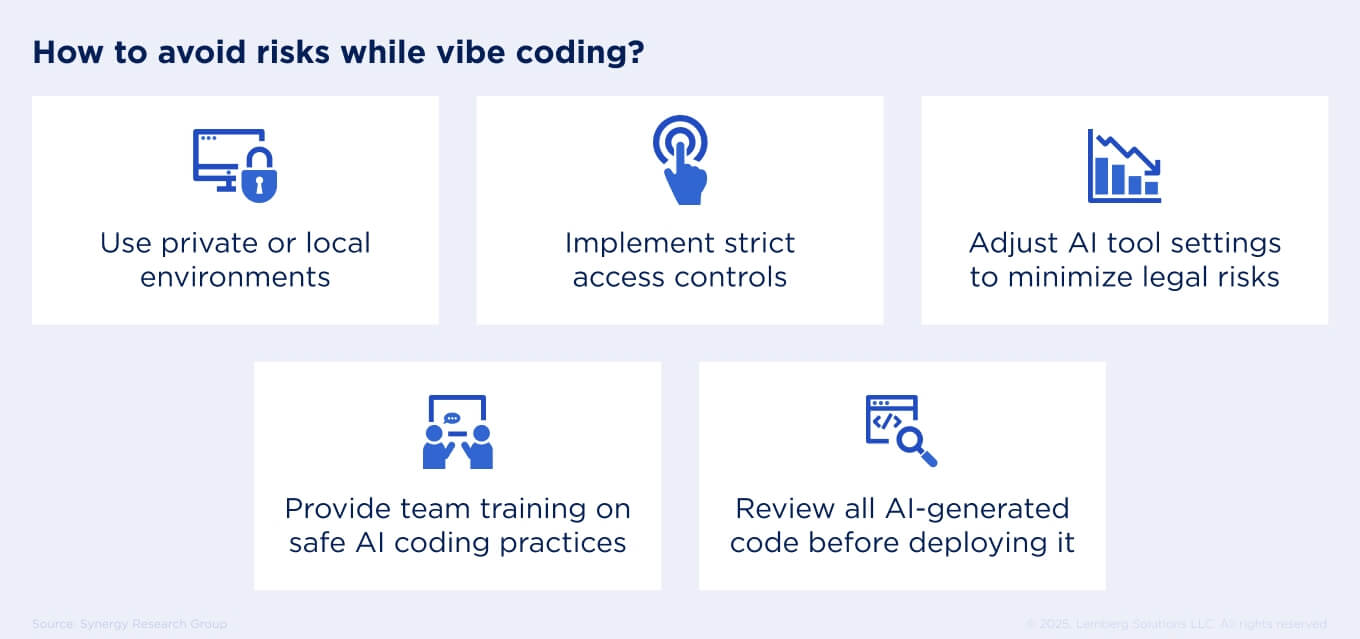Vibe coding is a new way of thinking about software development.
However, with all the buzz around it, several important questions also come – what type of companies would benefit the most from it, how to implement it securely into the processes, and how it will change the role of developers in the future.
In this article, our Web Development Lead, Taras Kruts, answers all the questions, explaining what vibe coding is and what it holds for businesses and development teams.
You can also explore the topic in more detail by watching our video on our YouTube channel.
What is vibe coding?
Vibe coding meaning refers to the approach to software development, where programmers incorporate artificial intelligence tools to generate code. Instead of writing it manually, developers provide an AI model with a text prompt that gives directions on what needs to be done. The AI model, in turn, generates code snippets in seconds in response to a specific request. If the code has errors, developers can ask the AI to debug it.
This concept was first introduced by Andrej Karpathy, one of the leaders in AI research. In February 2025, he posted a tweet describing vibe coding as a practice of handing much of the coding process over to LLMs. Since then, the new approach sparked a wave of discussion in the tech community, encouraging developers to use AI tools to vibe code their software ideas to life.
“Apart from speeding up development, vibe coding makes programming more creative. It lets developers experiment more and test their ideas, as the cost of failure is low,” says Taras Kruts about vibe coding potential.
Why is vibe coding gaining attention in the tech community?
Vibe coding transforms the role of the developer and how the software is built.
“It completely changes the economics of software development. Tasks that used to take days can now be prototyped in hours. That means shorter time-to-market, lower costs, and more room for experimentation. In other words, developers are moving beyond simple code typing – now they command AI tools to their intent – and that’s a big leap forward.”
In their recent research, software intelligence company Jellyfish found that around 90% of developers are using AI tools for programming. And while the AI-generated code cannot be called perfect all the time, vibe coding makes the development process quicker, allowing developers to be more productive. Therefore, more top-tier companies, such as Visa, Reddit, and DoorDash, are making vibe coding a crucial requirement for their potential candidates. This trend shows that the industry is growing in interest in AI-assisted coding, as it can speed up product delivery to the market, which is especially important for companies where being first matters most.
Is vibe coding something that any organization can realistically adopt?
Yes, companies of any type can adopt vibe coding into their processes. However, they will need a different approach.
For example, startups can benefit from vibe coding the most. As they usually operate with small teams and few resources, vibe coding allows them to test the ideas and deliver products much faster. Similarly, mid-size SaaS companies can also easily benefit from this approach. By automating some routine coding processes, their development teams can release the features more frequently.
However, adopting vibe coding for an enterprise is more complex. Integration requires proper governance, guardrails, and compliance measures to ensure security and reliability. Enterprise teams can easily leverage vibe coding without compromising standards – but only once all the aforementioned elements are in place.
For companies operating in highly regulated sectors, like healthcare, energy or government, incorporating vibe coding is the hardest as they need to be extremely careful about data security. However, as long as they use paid AI tools in private or local environments, they can safely experiment with vibe coding.
Can vibe coding speed up project delivery and reduce development costs?
Of course, the ability of AI tools to generate code significantly speeds up the development process.
“A task that usually takes 100 hours, with vibe coding can be done in eight hours or even less,” shares Taras Kruts.
Vibe coding allows for experimentation without requiring significant resources. However, the catch is that an AI coding assistant requires proper oversight. Therefore, you will need senior developers on your team who can guide the process, review the generated code, and ensure that everything is secure and maintainable.
Initially, this approach requires a larger upfront investment. Incorporating AI tools comes with additional expenses for licensing and cloud usage. So before applying vibe coding to your processes, choose the tool responsibly – the one that both provides value for you and fits your budget. However, in the long run, vibe coding can pay off as a few senior developers equipped with AI tools can replace a large team of developers. For some companies, it means doing more with fewer resources.
Below, check out the comparison table of traditional and vibe coding to understand the main differences between them.
| Vibe coding | Traditional coding | |
| Speed of development | Quick to start, but takes a lot of time to review the code | Slower development, as code is written manually |
| Cost | High upfront costs for implementing the approach and hiring skilled engineers; but more efficient in the long run, as a few senior developers can replace the whole team | High costs for hiring several developers; as the project grows, the cost will grow more |
| Purpose | Best suited for testing ideas, experimenting, and quick prototyping | More appropriate for a complex development project |
| Risks | All risks can be mitigated by choosing the right tools and following industry security and quality standards | Risks are lower if the developers follow best practices for data handling and code quality |
How does vibe coding change the role of a programmer in software development?
Vibe coding impact on software development has been largely positive. And there are several reasons to explain it.
First, it completely reshapes the role of the engineers. In the future, the typical role of the code typists will no longer be relevant. Instead of writing code manually, developers’ responsibilities will be more focused on managing and supervising the work of artificial intelligence. Developers will become more of strategists and architects, working on designing systems and solving complex problems.
Second, one of the vibe coding software development impact is that it can efficiently handle tasks typically assigned to juniors. Unfortunately, it will affect the entry-level specialists, making them less in demand. On the other hand, the demand for highly skilled specialists with hands-on expertise will be expected to rise.
And finally, one of the benefits of vibe coding in software development is that developers will be expected to move from simple executive roles to more leadership roles. They will work more effectively by understanding business needs, architecting solution logic, and optimizing AI-human collaboration.
When it comes to privacy, does vibe coding pose any risks?
Security and privacy risks associated with vibe coding come from the tools you use for it.
“If you use free or open AI tools, your prompts and code may be processed in the cloud. For sensitive projects, that’s a risk."
Also, coding with AI can hide legal issues. As AI trains on a large amount of data, it can generate code that is unauthorized or improperly licensed.
Nevertheless, all vibe coding security risks can be eliminated if properly handled. First of all, the key to secure coding is to find the proper setup. Therefore, thoroughly evaluate the existing tools before implementing them into your processes. Check their privacy policies and customization possibilities for your type of business.
Next, deploy your AI tools to run on private local environments to prevent leakage of your business and customer data. Additionally, implement strict access control to ensure that only authorized team members can use AI tools and interact with sensitive information. Remember, never share your confidential code or user data with external AI services unless it is officially permitted.
Another way to prevent AI coding risks is to conduct regular AI audits and provide training for your team to ensure they approach AI coding securely.

How can vibe coding be implemented into existing development processes?
Vibe coding must be implemented into the existing development processes gradually, so your team can adapt to the new approach. Also, here is a short list of the advice that might help you integrate vibe coding:
- Make sure to introduce the vibe coding into the projects where speed matters more than quality.
- Carefully consider tools for vibe coding, so they fit your requirements and security standards.
- Provide training to your team on how to write prompts and review AI-generated code.
- Establish clear expectations and guidelines on how and where to use vibe coding, clearly outlining the use cases.
- Mark AI-generated code in your project records or documentation – it will help to maintain transparency and an ethical approach to the use of AI.
- Proper guardrails are a must to ensure vibe coding fits flawlessly into Agile or DevOps workflows.
The most important thing is that you should not let AI take over the entire development process, automatically approving its code. Approach the AI-generated code, applying your critical thinking and programming skills. Also, ensure that you continually enhance your knowledge of AI to be more aware of what unknown risks to expect or useful features to leverage.
How to pick the right tool for vibe coding?
The market of vibe coding tools is evolving so quickly that new ones appear almost every week. So, instead of chasing the latest brand, make sure that the tool fits your needs.
Here are a few criteria to consider when choosing the ideal AI model.
Security and privacy. Verify that the tool complies with industry standards, has strict privacy policies, and has mechanisms for protecting your data.
Integration. Assess whether you can integrate it into your existing stack, like Git, CI/CD, or project management tools.
Usability. Make sure that it can help developers to experiment and test their product ideas.
Customization. Evaluate whether the tool can adapt to your domain knowledge and workflows.
And finally, scalability and support. Confirm that the AI tool provides long-term stability, technical support, and ongoing updates.

When starting with vibe coding, what should teams be careful about?
Developers should treat AI as their assistant, rather than relying entirely on its judgment. Therefore, the number one rule: don’t trust AI code blindly. It might look correct, but it can hide errors, security issues, or not match your standards. That’s why oversight of an experienced developer is non-negotiable. They need to validate and test AI-generated code before it goes live to ensure everything works as intended.
One more thing: don't use artificial intelligence tools everywhere you can – choose the cases that will bring you the most benefit. For example, vibe coding is great for prototyping, creating internal tools, or automating routine tasks. For critical and complex tasks, combine AI coding with thorough testing and oversight.

Wrapping up
Vibe coding is not a genius replacement for developers, but an assistant designed to automate the work of engineers. When implemented with careful oversight and security mechanisms, vibe coding has great potential to change software development as we know it today, making it faster and more productive.

